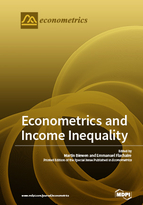Econometrics and Income Inequality
A special issue of Econometrics (ISSN 2225-1146).
Deadline for manuscript submissions: closed (31 January 2018) | Viewed by 171343
Special Issue Editors
Interests: labor economics; income distribution; education economics; microeconometrics
Special Issue Information
Dear Colleagues,
This Special Issue is devoted to the econometric analysis of income inequality and income distributions. Given the recent surge of inequality research, this Special Issue seeks to combine both theoretical and applied contributions which advance the econometric analysis of income inequality and income distributions. Possible topics include, but are not limited to, statistical inference for inequality measurement, inequality measurement with complex survey data, parametric or non-parametric modelling of income distributions, statistical decomposition methodology, methods to investigate the determinants of distributional change, causal inference in inequality measurement, and applications of such methods to substantive research questions in different fields of economics.
Prof. Martin Biewen
Prof. Emmanuel Flachaire
Guest Editors
Manuscript Submission Information
Manuscripts should be submitted online at www.mdpi.com by registering and logging in to this website. Once you are registered, click here to go to the submission form. Manuscripts can be submitted until the deadline. All submissions that pass pre-check are peer-reviewed. Accepted papers will be published continuously in the journal (as soon as accepted) and will be listed together on the special issue website. Research articles, review articles as well as short communications are invited. For planned papers, a title and short abstract (about 100 words) can be sent to the Editorial Office for announcement on this website.
Submitted manuscripts should not have been published previously, nor be under consideration for publication elsewhere (except conference proceedings papers). All manuscripts are thoroughly refereed through a single-blind peer-review process. A guide for authors and other relevant information for submission of manuscripts is available on the Instructions for Authors page. Econometrics is an international peer-reviewed open access quarterly journal published by MDPI.
Please visit the Instructions for Authors page before submitting a manuscript. The Article Processing Charge (APC) for publication in this open access journal is 1400 CHF (Swiss Francs). Submitted papers should be well formatted and use good English. Authors may use MDPI's English editing service prior to publication or during author revisions.
Keywords
- Inequality measurement
- Complex survey data
- Incomplete data
- Robust inference
- Modelling of top tails
- Decomposition methods
- Wage inequality







